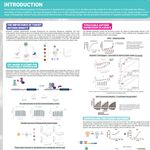OCT 31, 2024 9:00 AM PDT
PART 2: Utilizing the 6-base genome to investigate the dynamics of enhancer DNA methylation during cellular differentiation
Speaker
Event Date & Time
Date: October 31, 2024
Time: 9:00am PDT, 11:00am CDT, 12:00pm EDT
Abstract
In part 2 of this webinar, Dr. Emily Hodges, assistant professor of biochemistry at Vanderbilt University, will reveal new data that illustrates how the Hodges Lab is utilizing the 6-base genome to investigate the dynamics of enhancer DNA methylation during cellular differentiation.
Dr. Hodges will discuss how the advanced 6-base genome solution, duet multiomics solution evoC, provided a multidimensional view that allowed the team to investigate the correlation of methylation state and chromatin accessibility at specific sites across the genome.
Specifically:
- Genome-wide detection of 5-hydroxymethylcytosine revealed active demethylation begins ahead of chromatin and transcription factor activity, while enhancer hypomethylation persists long after these activities have dissipated.
- Timepoint-specific methylation states predict past, present and future chromatin accessibility using machine learning models.
Until recently, we have been measuring global 5hmC with limited success in identifying genomic locations of 5hmC at base pair resolution. With single-base resolution data, we are able to precisely identify changes at individual gene enhancers, providing a detailed molecular understanding of how these changes impact gene regulatory programming. -Dr. Emily Hodges
Dr. Hodges research specialty is DNA methylation and non-coding gene regulatory variation in evolution, development, and disease.
About duet evoC
The combinatorial genetic and epigenetic technology provides single-base-resolution sequencing data that reveals standard four-base sequencing (A, G, C, and T), and distinguishes between 5-methylcytosine (5mC) and 5-hydroxymethylcytosine (5hmC), on the same DNA molecule. This added resolution will allow greater power in detecting disease associations, identifying novel biomarkers, developing disease classifiers, and monitoring the progression of disease.
You May Also Like
FEB 25, 2025 | 1:00 PM
C.E. CREDITS
Quality efforts in the clinical laboratory are always under the microscope- a hyper-focus for laboratorians from start to finish. Recognizing the external factors that affect hemostasis test...
Join this year's poster presenters in the Poster Hall during the Poster Networking Hour, Wednesday, September 20th, from 10:00 AM –11:00 AM PDT , to chat live about their posters a...
Join this year's poster presenters in the Poster Hall during the Poster Networking Hour, Wednesday, March 5th, from 10:00 –11:00 AM PDT , to chat...
Loading Comments...





